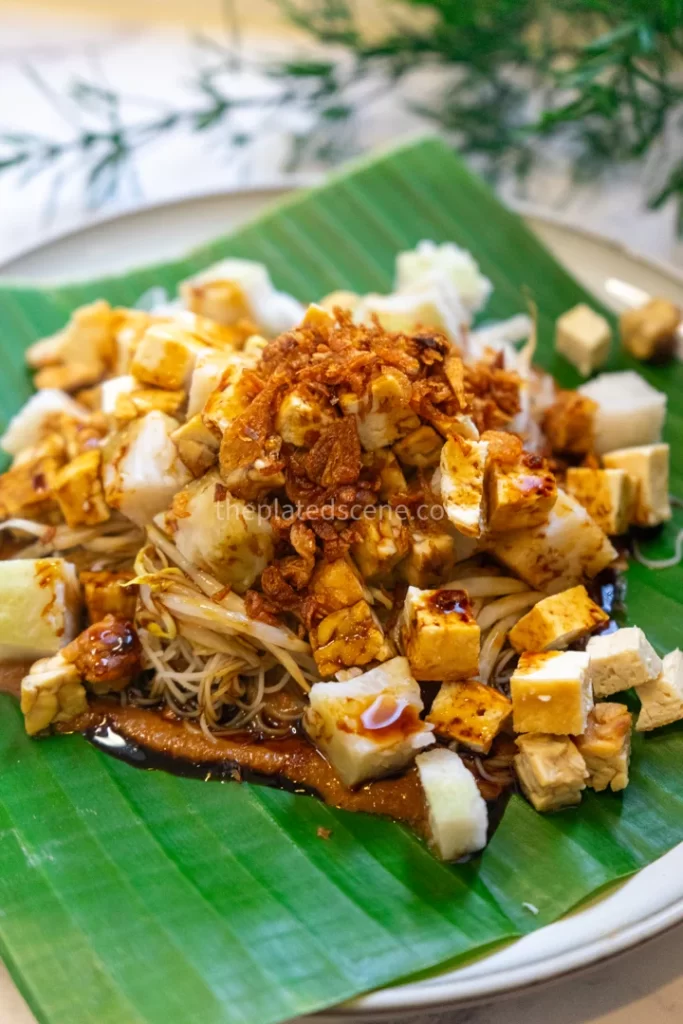If you’ve ever visited Indonesia, chances are you’ve encountered the vibrant and colorful world of street food. From savory skewers to sweet treats, Indonesian street food offers an endless variety of dishes representing the country’s rich culinary heritage. One dish that stands out for its balance of flavors and textures is Ketoprak. Originating from Jakarta, Ketoprak is a beloved street food snack that combines simple, wholesome ingredients into a mouthwatering meal. Whether served as a light lunch or a filling dinner, Ketoprak is satisfying and nutritious.
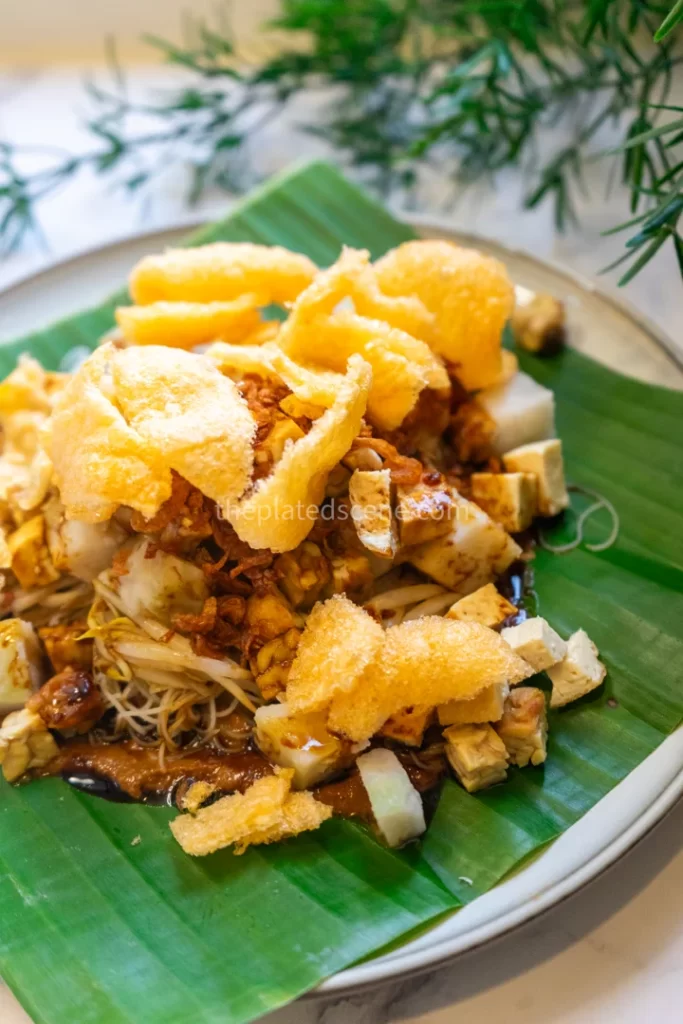
At its core, Ketoprak is a vegan salad. It blends chewy rice cakes (lontong) with crunchy bean sprouts. The richness of fried tofu complements the silky, savory peanut sauce. This dish showcases the harmonious flavors of Indonesian cuisine. Sweet, salty, spicy, and savory elements create something special. The peanut sauce is even more flavorful with garlic, adding a unique twist to the traditional dish.
Interestingly, Ketoprak shares similarities with Gado-Gado, another iconic Indonesian dish. Both dishes feature rice cakes, tofu, fresh vegetables, and a peanut sauce. However, there are key differences that set them apart.
Table of Contents
Ketoprak vs. Gado-Gado: What’s the Difference?
While Ketoprak and Gado-Gado both highlight rice cakes and a peanut sauce, there are a few notable differences:
- Rice Cake: Both dishes use rice cakes (lontong), but Ketoprak’s rice cakes are typically softer and are more absorbent than the peanut sauce, giving the dish a different texture and flavor profile. Gado-Gado’s rice cakes tend to be firmer and can sometimes be accompanied by additional sides like boiled potatoes or rice.
- Peanut Sauce: While both dishes feature a peanut sauce, Ketoprak’s peanut sauce has the added richness of garlic in its ingredients. The sauce in Ketoprak tends to be thicker, slightly sweeter, and a bit more savory, thanks to the soy sauce and garlic. While creamy and slightly sweet, Gado-Gado’s peanut sauce typically has a more tangy kick, often from tamarind or lime juice.
- Simplicity vs. Variety: Ketoprak is often simpler, relying on just a few ingredients like tofu, rice cakes, bean sprouts, and peanut sauce. Gado-Gado, however, tends to be more diverse in terms of ingredients, often featuring an assortment of vegetables, potatoes, eggs, and sometimes even tempeh or rice cakes (lontong). This variety gives Gado-Gado a more complex texture and flavor profile.
Despite these differences, both Ketoprak and Gado-Gado offer a fantastic combination of textures and flavors, and both have a place in Indonesians’ hearts (and bellies). If you’re new to Indonesian food, trying both dishes is a great way to explore the country’s rich culinary heritage.
Modifications You Can Make to Ketoprak
One of the great things about Ketoprak is its flexibility. While the traditional version is already delicious, you can make many modifications to suit your taste or dietary needs. Here are some ways you can customize your Ketoprak:
- Make it spicy: Add more fresh chilies and chili paste, or sprinkle chili flakes on top for extra heat.
- Vegan or vegetarian: Ketoprak is naturally vegan. Add plant-based proteins like tempeh and tofu for added texture and flavor. You can also use plant-based kerupuk ketoprak (orange crackers made from garlic, cassava flour, and seasoning) instead of shrimp crackers to keep it vegan. Alternatively, shrimp crackers can be used for a different flavor.
- Swap rice cakes: For a keto-friendly or low-carb version, substitute rice cakes (lontong) with cauliflower rice or spiralized zucchini. This keeps the dish light but satisfying.
- Add more vegetables: Besides bean sprouts, shredded carrots, spinach, or cabbage for extra crunch and nutrition.
- Adjust sweetness or saltiness: Play with the peanut sauce balance by adding more sugar for sweetness or increasing the soy sauce for a saltier flavor.
- Top with extra crunch: Add toasted sesame seeds or chopped peanuts for an added crunch along with fried shallots and kerupuk ketoprak.
- Cucumber: While traditional Ketoprak includes cucumber slices for a refreshing contrast, this recipe skips it for a slightly different take on the dish.
Ketoprak is versatile and can be easily tailored to your preferences. Whether you like it spicier, richer, or with added crunch, it’s a dish that can be made to suit any taste.
Ingredients for Ketoprak
Rice cakes (Lontong)
Lontong (link to Wikipedia article) are traditional Indonesian rice cakes made by cooking rice, compressing it into a dense form, and then wrapping and steaming it. The result is a chewy, compact block of rice that serves as a perfect base for absorbing the rich peanut sauce. Lontong is a staple in Indonesian cuisine, often served with dishes like Ketoprak, Soto, and Gado-Gado.
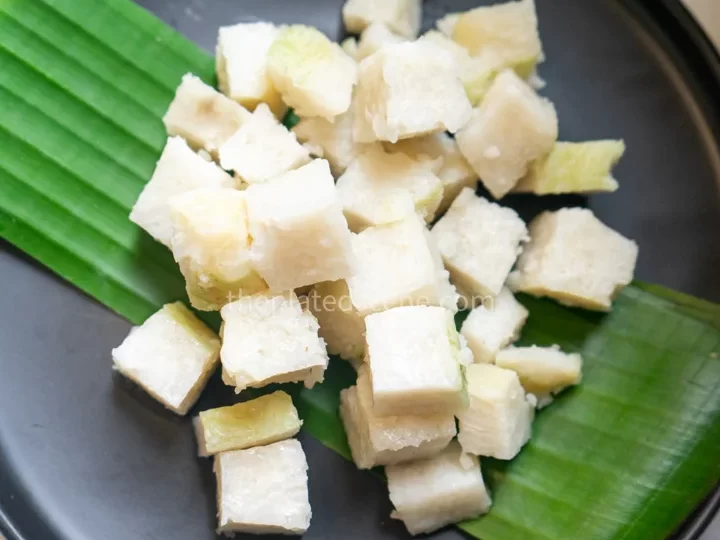
If you’re in Indonesia, lontong can usually be found at wet markets or Asian grocery stores. For those outside Indonesia, store-bought lontong is often available in the freezer section of international grocery stores. It’s a convenient option to save time. You can also make your own at home by steaming rice and pressing it into a mold to firm it up.
If you are following a low-carb or keto diet, cauliflower rice is an excellent substitute for lontong. To make cauliflower rice, pulse cauliflower florets in a food processor until they resemble rice grains, then lightly sauté or steam them. The texture will be slightly lighter than traditional lontong but absorb the peanut sauce well.
Tofu
Tofu, made from soybeans, is a versatile ingredient known for its high protein content. In Ketoprak, you fry the tofu to achieve a crispy, golden texture on the outside while keeping the interior soft. This creates a satisfying contrast with the crunchy bean sprouts and chewy rice cakes. Tofu also provides a great source of plant-based protein, making it essential for those seeking a vegan or vegetarian protein source.
For the best texture, it is essential to use firm tofu. Firm tofu holds its shape better during cooking, which is crucial for this recipe since it will be fried. Once fried until golden brown and crispy, cut the tofu into 1cm x 1cm cubes. This ensures that each piece is crispy and easily mixed with the other ingredients. If you prefer a lighter version, you can grill the tofu instead of frying it.
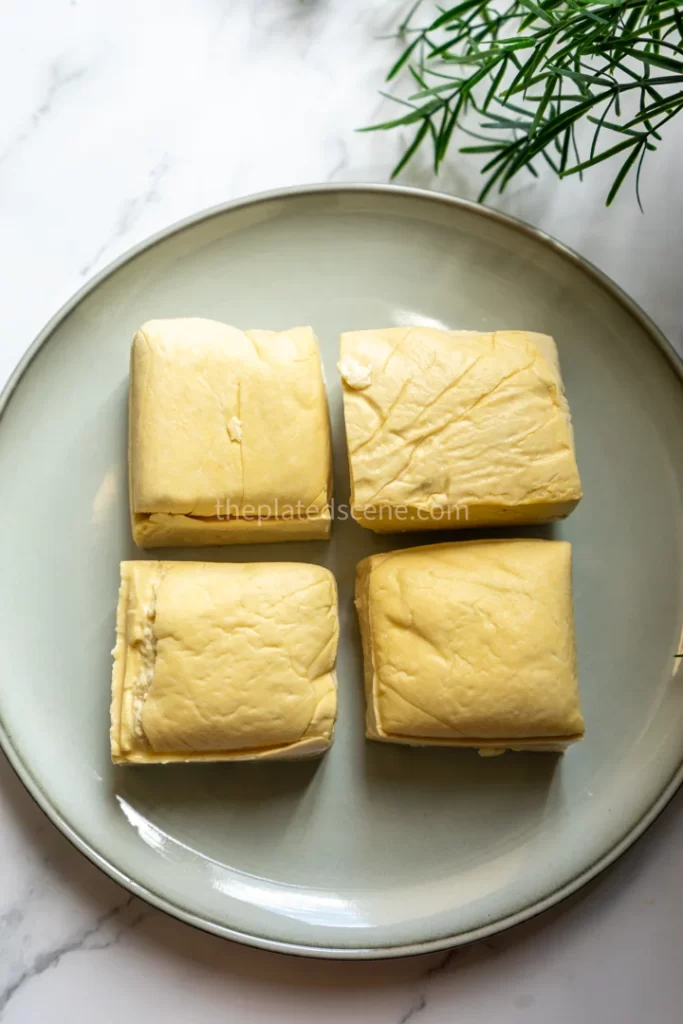
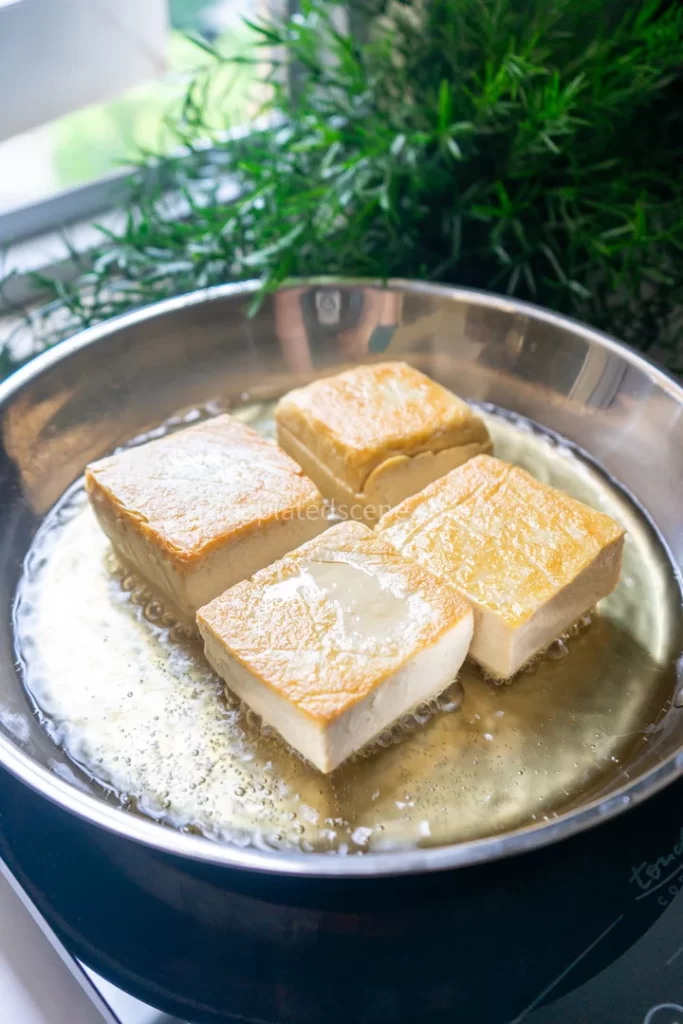

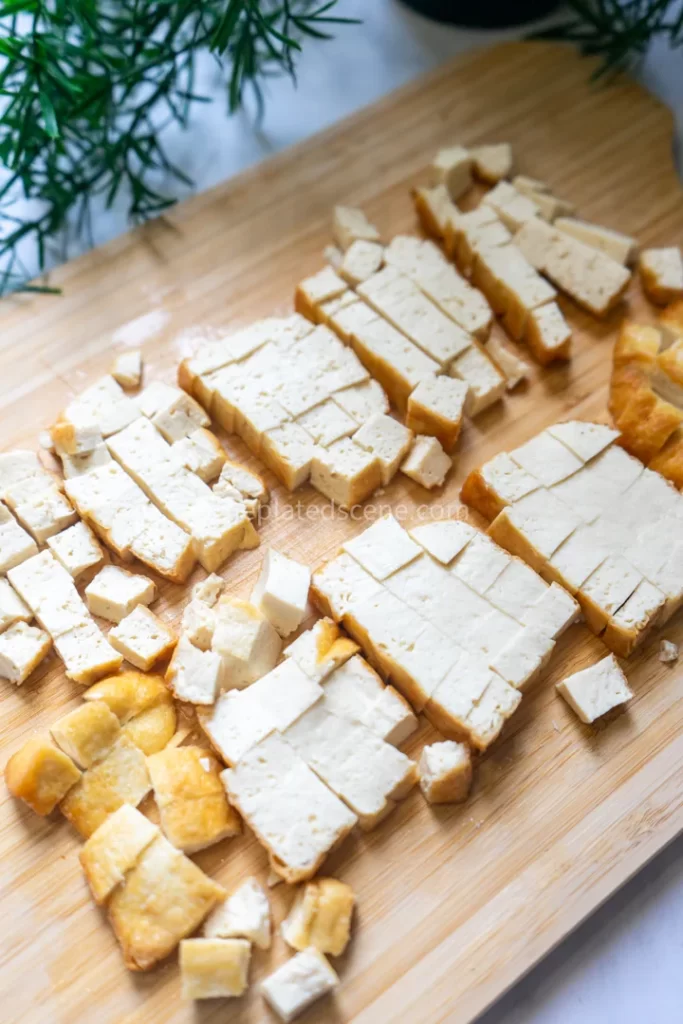
Tempeh
Tempeh is a fermented soy product that adds great flavor and texture to Ketoprak. It’s packed with protein, fiber, and probiotics that promote digestive health. Made by fermenting cooked soybeans and pressing them into a firm block, tempeh has a nutty, earthy flavor. Unlike tofu, which is made from soy milk, tempeh retains the whole soybean. This gives it a denser, firmer texture. It’s the perfect addition to Ketoprak, complementing the creamy peanut sauce and crispy tofu.
In this recipe, fry the tempeh until it turns golden and crispy, adding a delightful crunch while maintaining its dense, hearty bite. After frying, cut it into 1cm x 1cm cubes to allow it to absorb the rich peanut sauce. The nutty flavor of the tempeh beautifully balances with the savory and sweet elements of the sauce, making every bite full of texture and depth.
Tempeh is a popular choice for vegans and vegetarians due to its high protein content. It’s a great meat alternative and provides a “meaty” bite that complements the dish. In Ketoprak, tempeh adds a chewy texture and an extra savory layer. This elevates the dish from good to unforgettable.
Whether you’re looking for a healthy and flavorful protein source or want to try something new, tempeh is an essential part of Ketoprak that enhances the dish’s flavor and nutritional value.
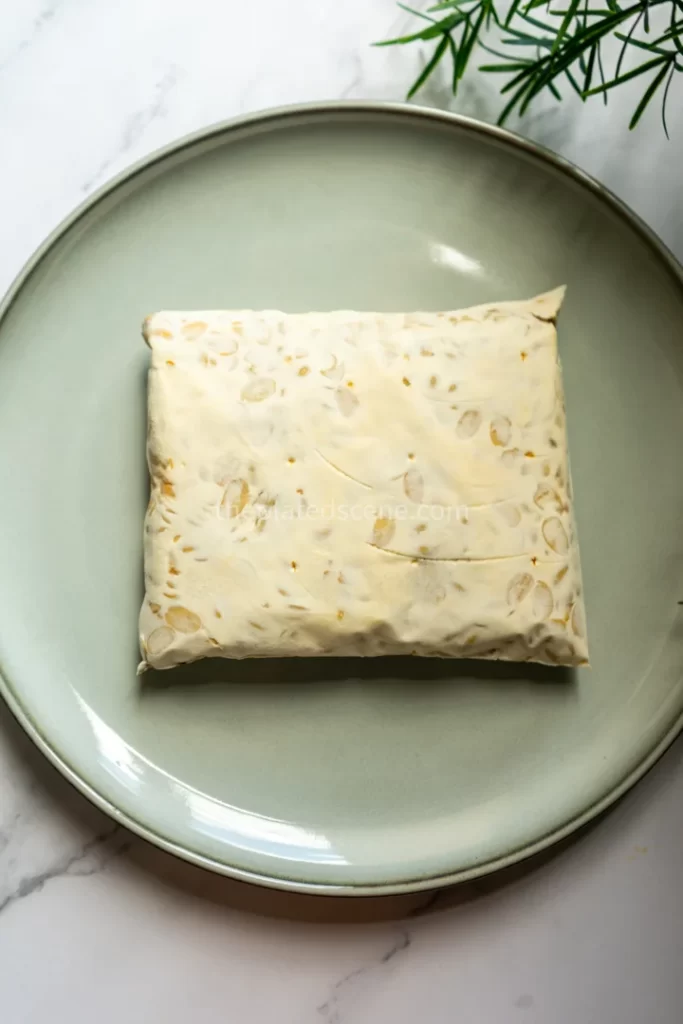
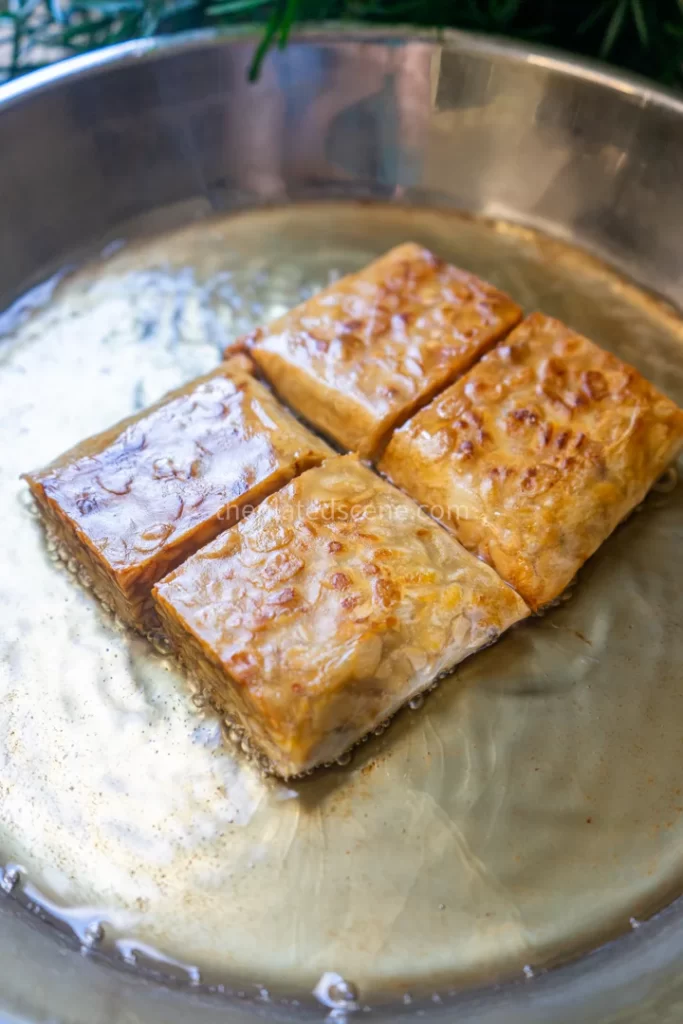
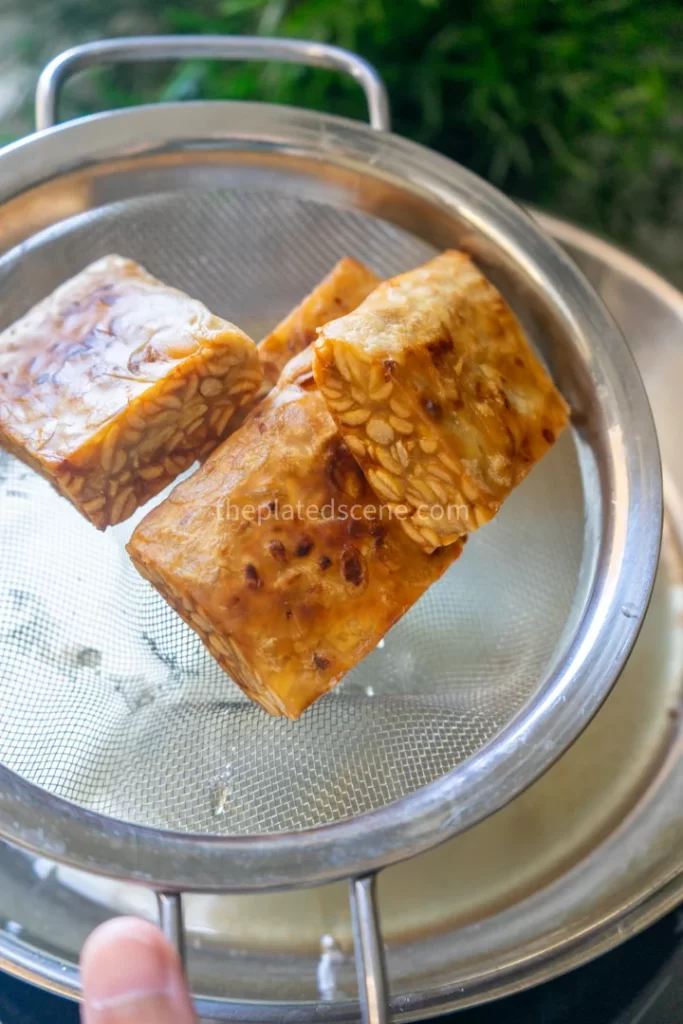
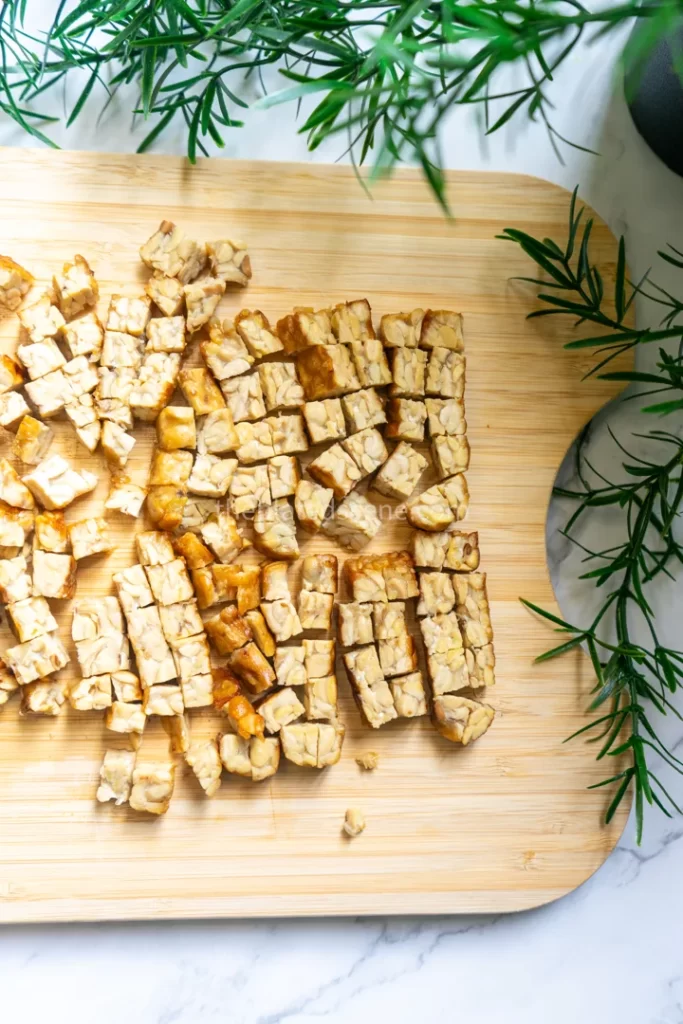
Bean sprouts
Bean sprouts are young, tender shoots of beans, typically mung beans. They provide a fresh crunch that balances the rich peanut sauce. These sprouts are packed with nutrients, including vitamins A, C, and K. They also contain minerals like iron and magnesium, making them a healthy addition to the dish.
But it’s not just their nutritional value that makes them essential in Ketoprak—their texture and flavor. The crispiness of bean sprouts adds a refreshing contrast to the chewy rice cakes and crispy tofu and tempeh. This textural variety elevates the dish by adding a light and crunchy element, helping to cut through the richness of the peanut sauce and fried ingredients.
To prepare bean sprouts for Ketoprak, it’s best to steam or briefly boil them. This helps to soften them slightly while retaining their freshness and crunch. Blanch the bean sprouts in hot water for about 1-2 minutes or steam them for a few minutes until they are just tender. This process helps to preserve their flavor and nutrients, ensuring they maintain their delicate texture while absorbing the flavors of the dish.
Moreover, bean sprouts are a low-calorie, high-fiber vegetable, which makes them an excellent choice for adding volume and freshness to the dish without overwhelming it. They also absorb the flavors of the peanut sauce beautifully, making each bite more satisfying. Their delicate flavor pairs well with the more robust, nutty, and savory ingredients in Ketoprak, allowing them to enhance the overall harmony of the dish.
In essence, bean sprouts are more than just a garnish—they are a vital component that provides freshness, crunch, and a nutritious boost, making Ketoprak a well-rounded, flavorful, and satisfying dish.
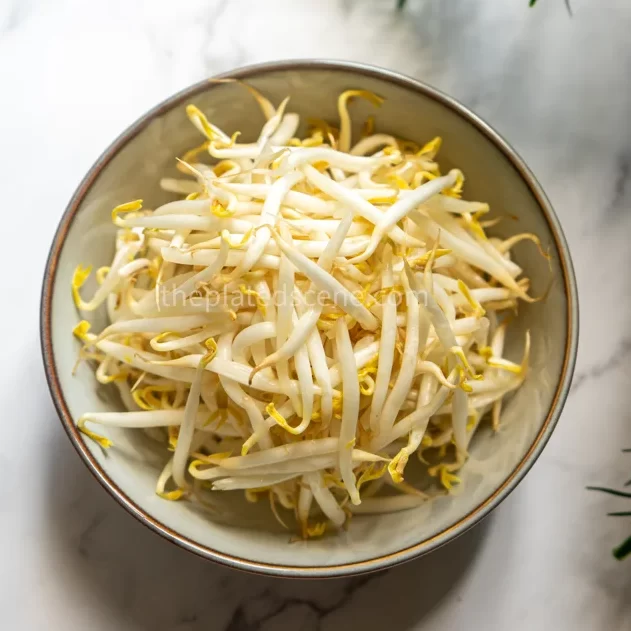
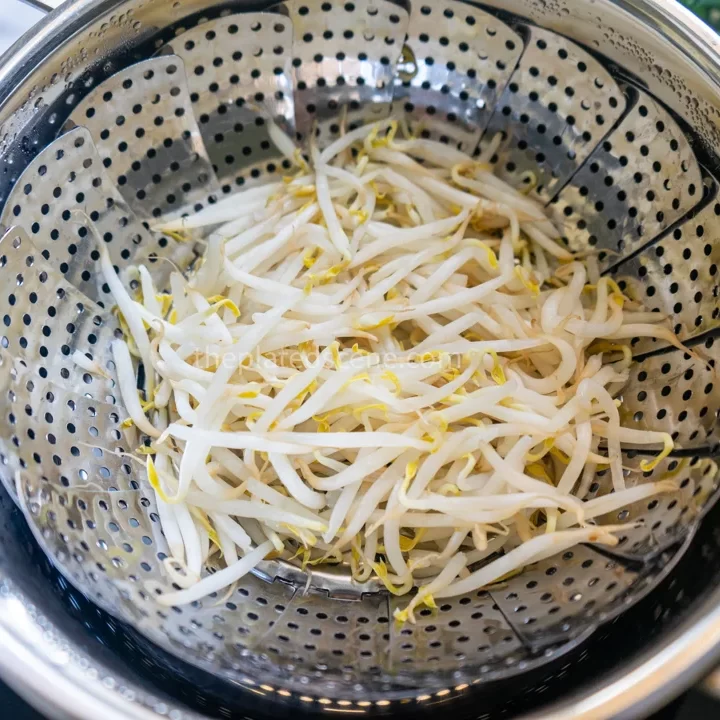
Beehoon noodles
Beehoon, or rice vermicelli, are thin, translucent noodles made from rice flour. In Ketoprak, they add softness and chewiness. They balance the richness of the peanut sauce and complement the other ingredients. These noodles are popular in many Southeast Asian cuisines, especially in Indonesia and Singapore. They are a key ingredient in dishes like fried beehoon and soup beehoon.
The neutral flavor of beehoon allows it to absorb the peanut sauce beautifully, helping to carry the savory, creamy flavors across each bite. The lightness of beehoon is essential in Ketoprak, providing an additional layer of texture without overwhelming the other ingredients like rice cakes, tofu, and tempeh. Their delicate chewiness contrasts wonderfully with the crispy tofu, tempeh, and crunchy crackers, creating a well-rounded dish.
To prepare beehoon for Ketoprak, boil or soak the noodles in hot water for about 2-3 minutes until they become soft and tender. If you use dried beehoon, soaking them in warm water is quicker. After soaking or boiling, drain them thoroughly to remove any excess water, ensuring the noodles don’t make the dish soggy. If you prefer a more traditional approach, steam the beehoon noodles for a firmer texture. Once ready, add them directly into the Ketoprak, mixing them with the peanut sauce, rice cakes, tofu, tempeh, and bean sprouts for a flavorful combination of textures.
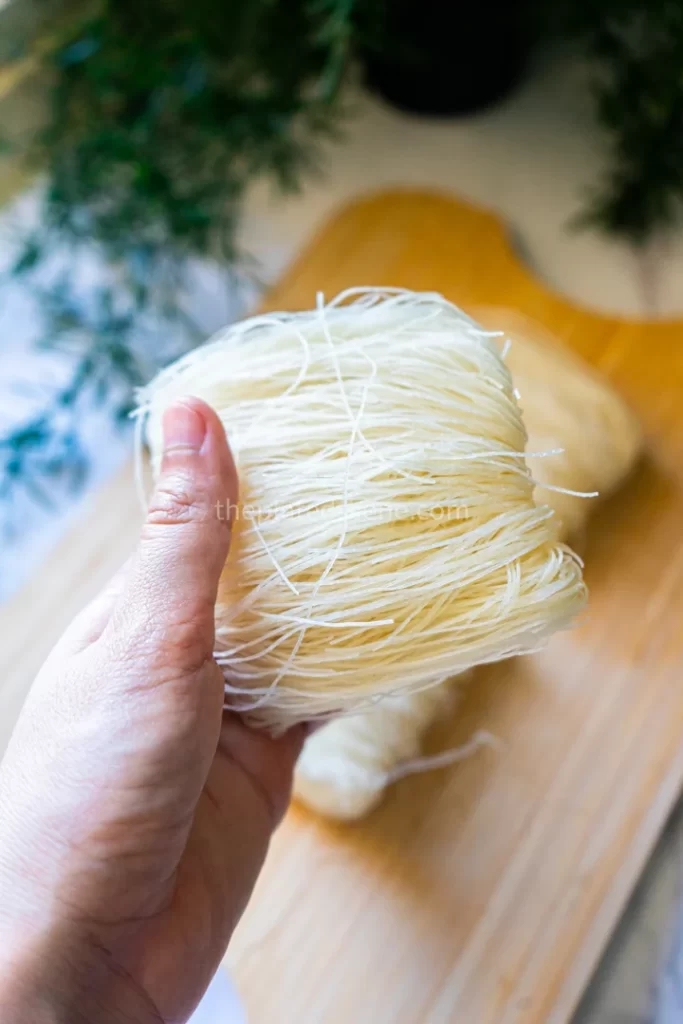
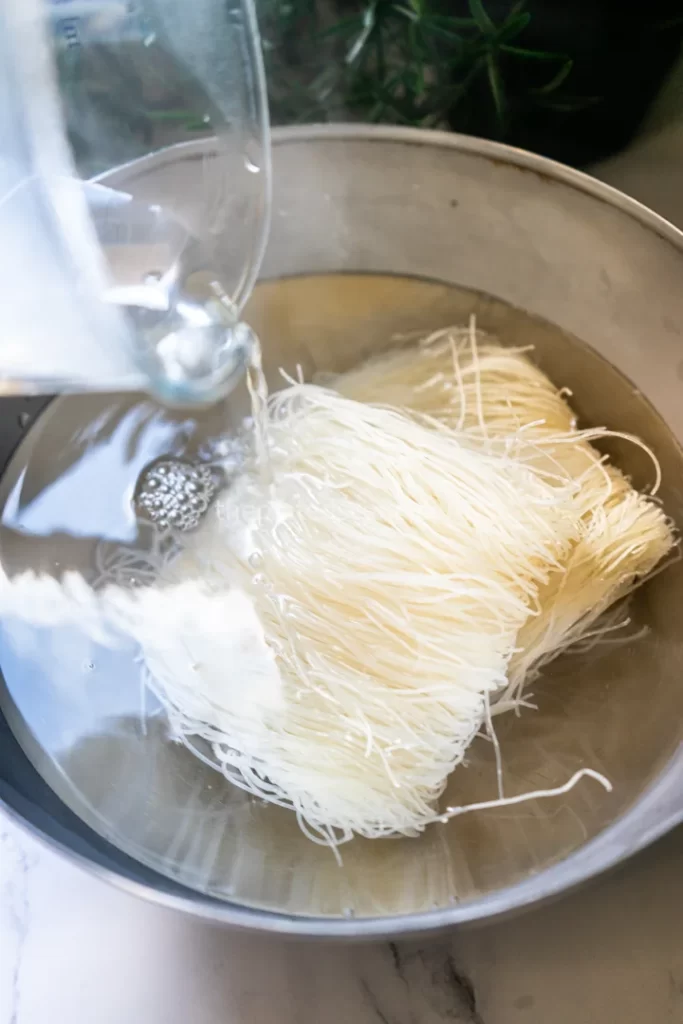
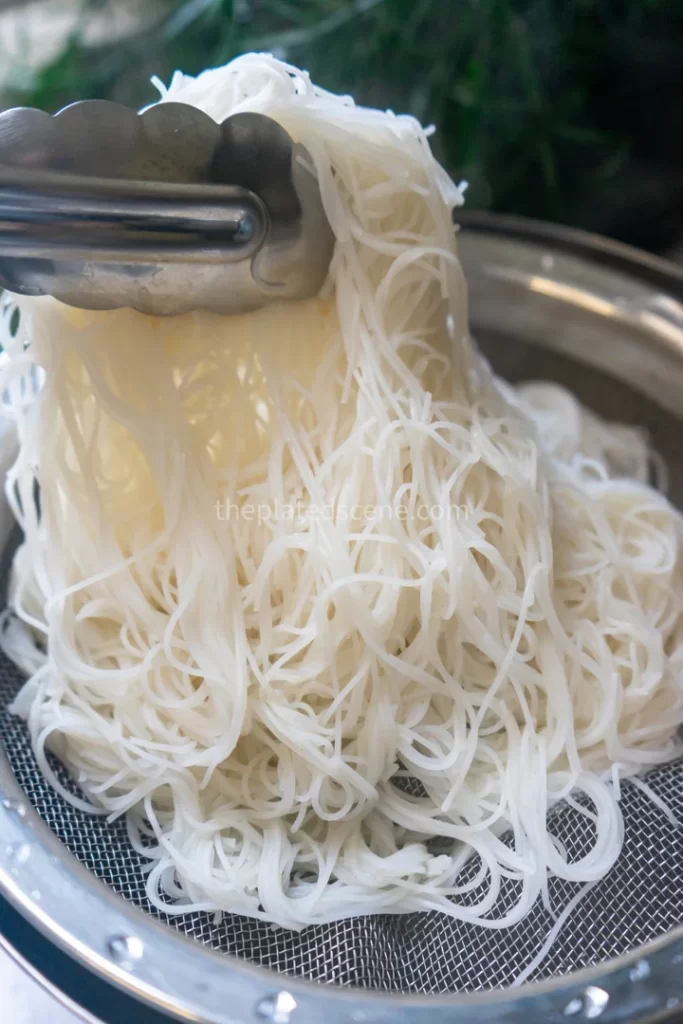
Beehoon noodles provide a light, satisfying base that enhances the overall harmony of the dish, making it even more enjoyable. Their ability to absorb the rich peanut sauce and blend it with the other fresh and crunchy elements makes them an important addition to this classic Indonesian salad.
Kerupuk Ketoprak
Kerupuk Ketoprak is a signature, crunchy topping for Ketoprak, adding an essential element of texture to the dish. It’s a crunchy, traditionally bright orange cracker, easily recognizable in Indonesian street food markets. These crisp crackers have a slightly savory, garlicky flavor, making them the perfect complement to the richness of the peanut sauce and the soft, chewy textures of the rice cakes, tofu, and tempeh.
Kerupuk ketoprak is traditionally made from garlic, cassava flour (or tapioca flour), sugar, salt, and various seasonings. The garlic gives it a distinctive savory kick, while the cassava flour gives the crackers their signature crispness. When fried, these ingredients combine to create a light, crispy texture that shatters easily in your mouth, adding a satisfying crunch. The sugar and salt balance each other out, giving the crackers a lightly sweet yet savory taste.
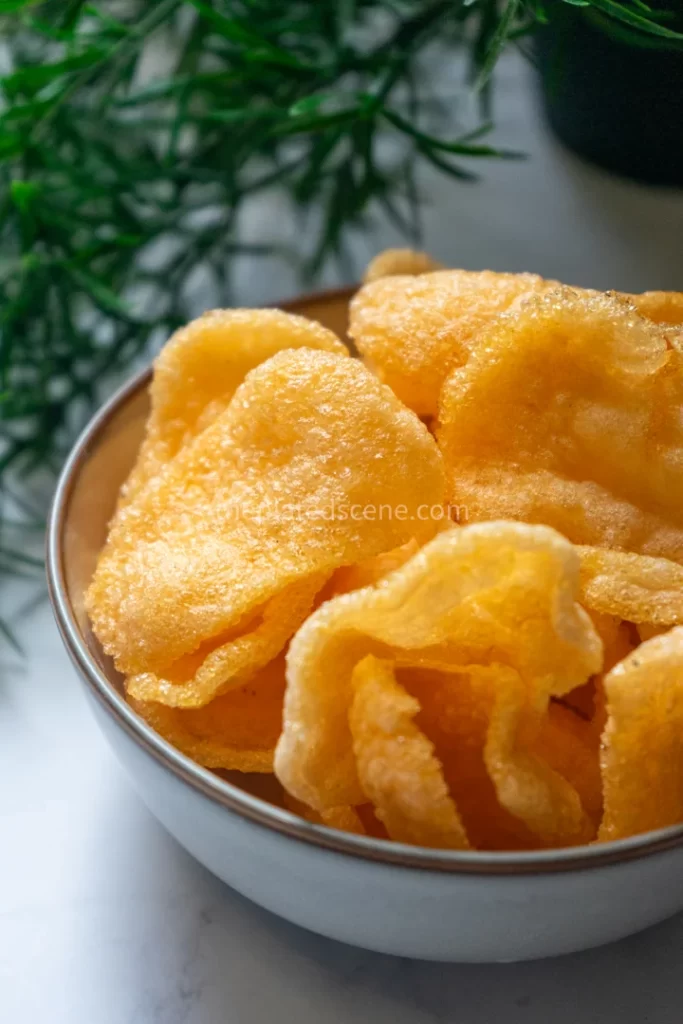
Typically found at wet markets and local vendors in Indonesia, kerupuk ketoprak is often freshly made and sold in bulk. If you’re outside of Indonesia, you can still find kerupuk ketoprak in specialty Asian grocery stores or online. Alternatively, if it’s not available, shrimp crackers can be used as a variation. While shrimp crackers offer a different flavor profile, they still provide the necessary crunch and texture with a slight seafood taste.
For the best experience, crush the kerupuk ketoprak slightly before sprinkling it over the dish. You can serve it whole or break it into pieces and mix it in just before serving to maintain its crispness. As you eat, the crunch of the crackers blends with the rich peanut sauce and fresh vegetables, enhancing the dish’s overall flavor profile.
Peanut Sauce for Ketoprak
This recipe is for a thicker version of Ketoprak peanut sauce, which can be stored longer. When you’re ready to use it, simply dissolve it with more water (up to your desired consistency) to achieve the perfect texture for serving.
The rich and creamy peanut sauce is the heart and soul of Ketoprak. This sauce is savory, slightly sweet, with a touch of spice, and perfectly ties together the dish’s components. Below is the guide on how to prepare it
Step 1: Fry or Roast the Peanuts
Begin by frying the raw peanuts to bring out their rich, nutty flavor. There are three methods you can use to fry/roast the peanuts:
- Frying in a Pan with Oil:
Heat a small amount of oil (just enough to coat the bottom of the pan) over medium heat. Once the oil is hot, add the raw peanuts. Fry the peanuts, stirring constantly to prevent them from burning. It should take 5-7 minutes to fry them until they turn golden brown and aromatic. Once done, remove the peanuts from the pan and let them cool slightly.
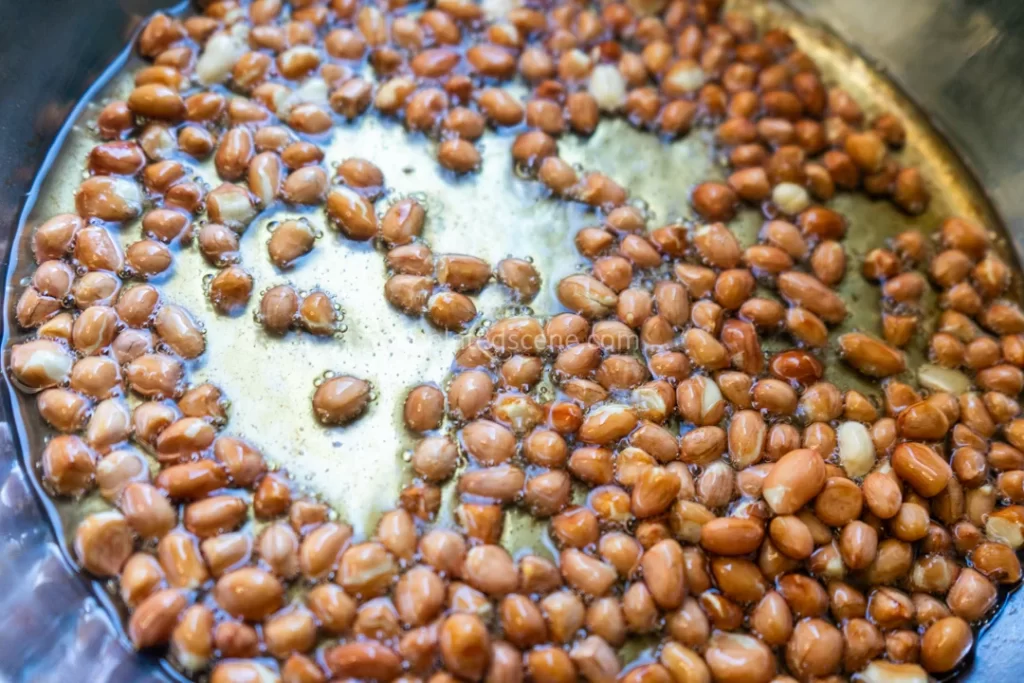
- Using an Air Fryer:
Preheat your air fryer to 180°C (350°F). Place the raw peanuts in the air fryer basket in a single layer. Set the timer for 10-12 minutes, shaking the basket halfway through the cooking time to ensure even frying. After the peanuts are golden and fragrant, remove them from the air fryer and cool slightly.
- Roasting in the Oven:
Preheat your oven to 180°C (350°F). Spread the raw peanuts evenly on a baking sheet in a single layer. Roast the peanuts for about 10-12 minutes, stirring halfway through to ensure they roast evenly. Keep a close eye on them to prevent burning. Once roasted, remove them from the oven and let them cool slightly.
Once the peanuts are fried or roasted and cooled, they are ready to be used in the next steps of the recipe.
Step 2: Prepare the Garlic
Note: This step is optional as it is a personal preference. The original recipe traditionally uses raw garlic, giving the sauce its distinctive flavor. However, to mellow the sharpness of the garlic and create a smoother, more balanced flavor, you can lightly fry the garlic.
To do this, heat a small amount of oil and fry the garlic until it turns golden brown. This will reduce the pungent “garlicky flavor” and add a depth of flavor that is less intense compared to using raw garlic.
Step 3: Blend the Ingredients
In this step, add all the ingredients into the blender and blend them until smooth. Place the fried peanuts, chili padi, fried garlic, sweet soy sauce, tamarind paste mixture, gula Malaka, and salt into a bowl or a blender. Gradually add the hot water to achieve the desired consistency for the sauce. Start with 50ml and add more if needed.
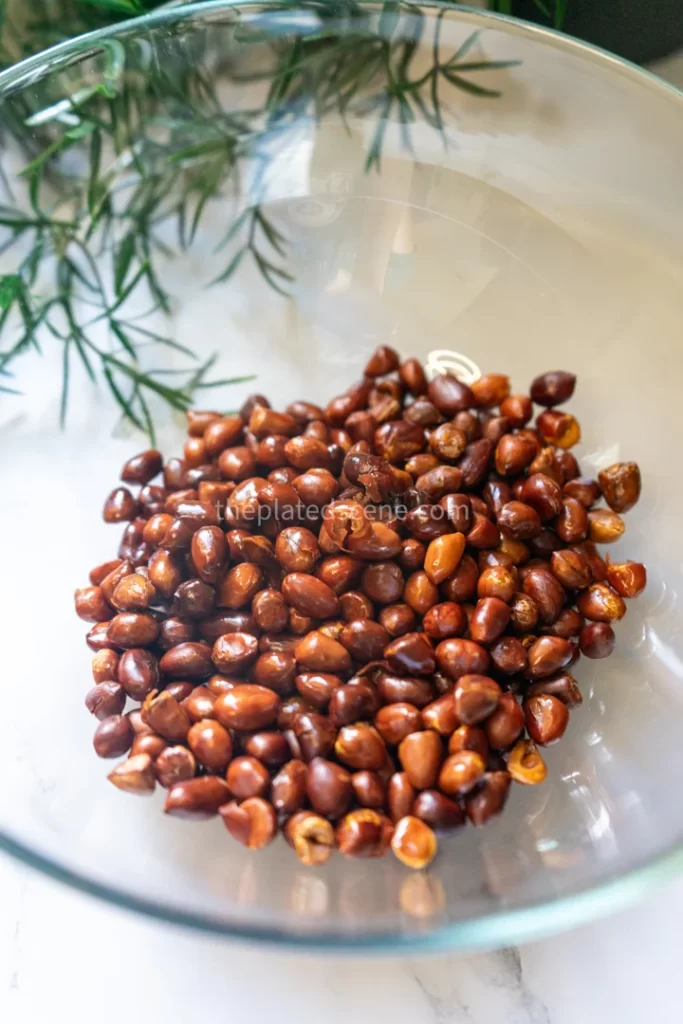
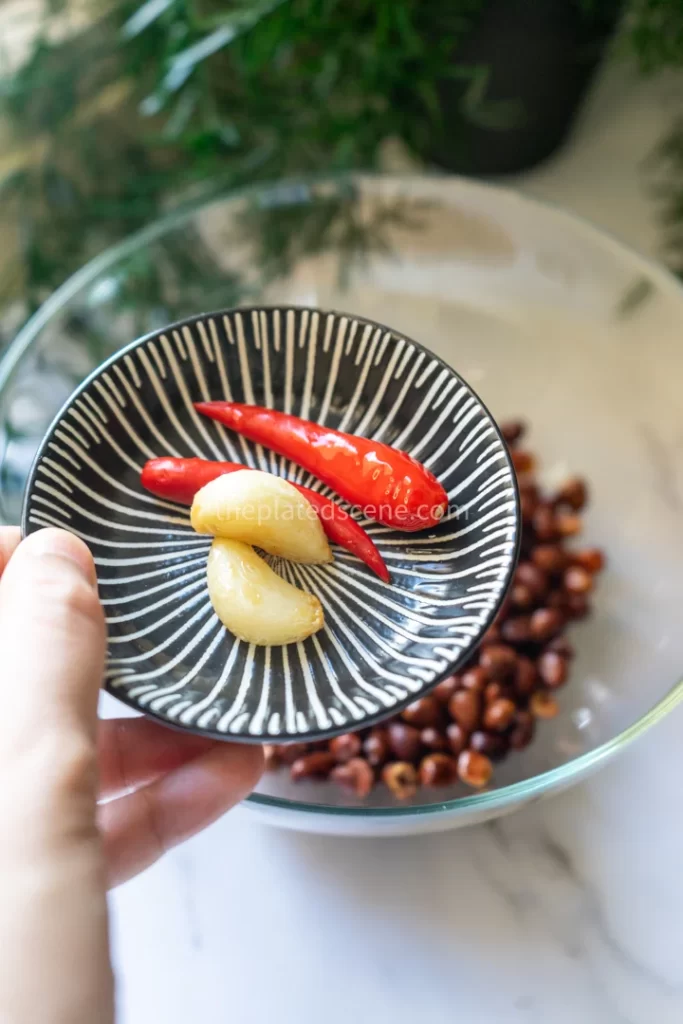
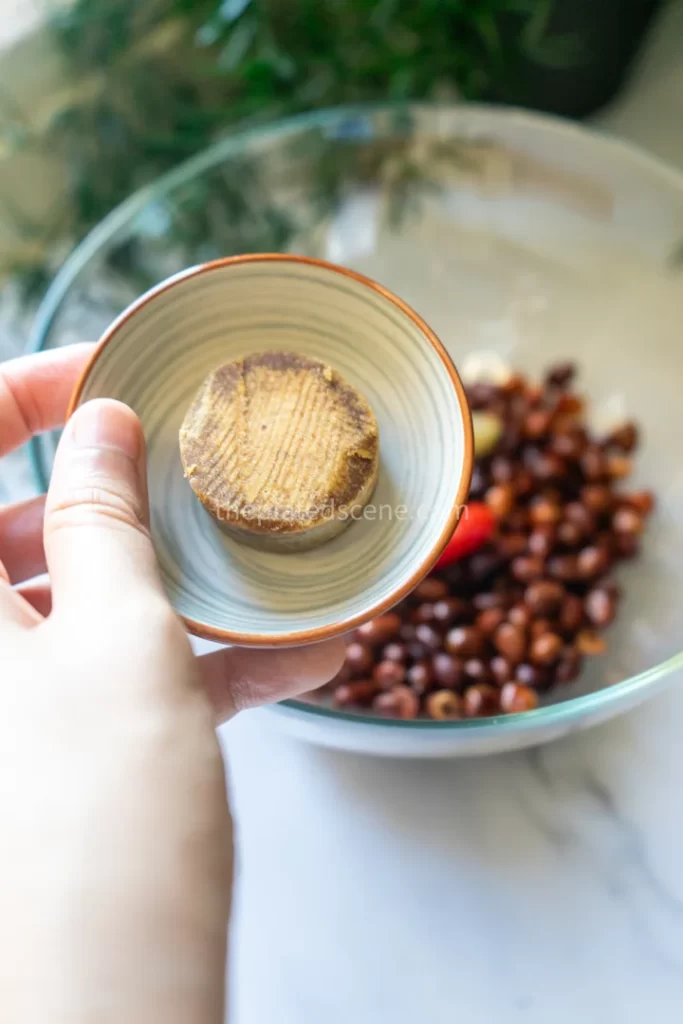
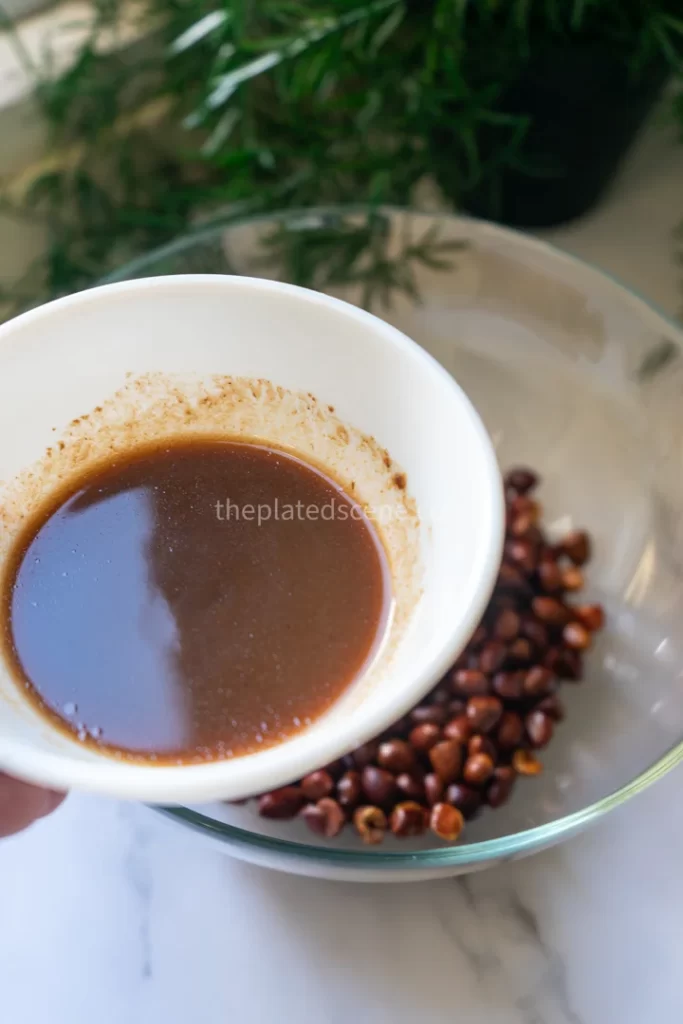

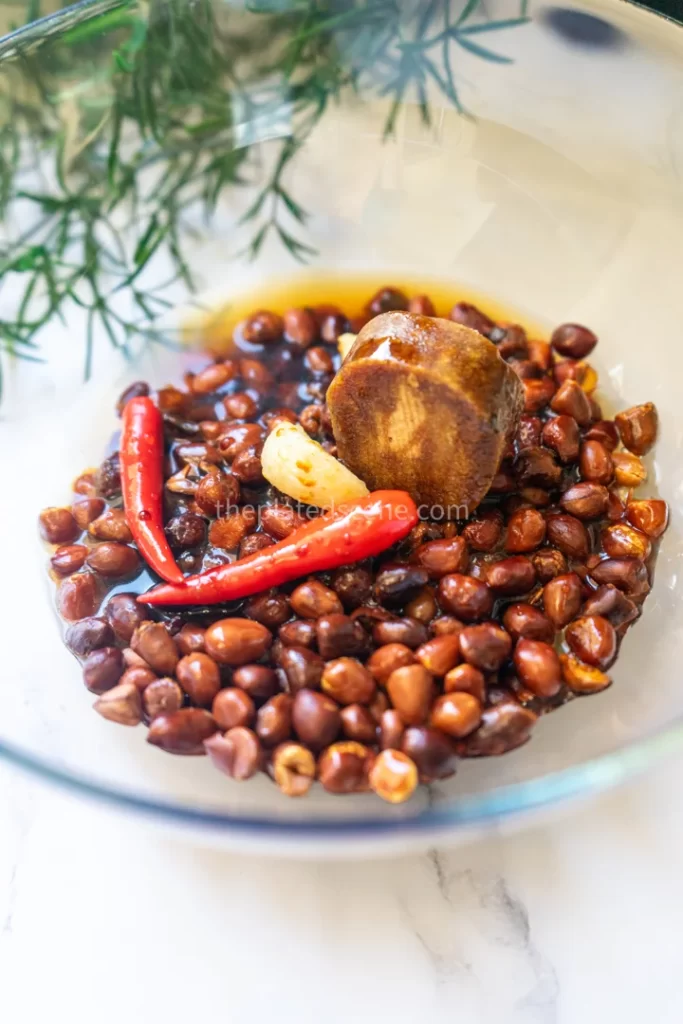
You have two options for blending:
- Using a Hand Blender:
Place everything in a deep bowl or container. Use your hand blender to blend the ingredients. Move the blender around to ensure an even, smooth texture. Add more water as necessary to achieve the consistency of the sauce you like. The hand blender is perfect for creating a silky smooth sauce with minimal effort, and you can control the consistency by adjusting the water.
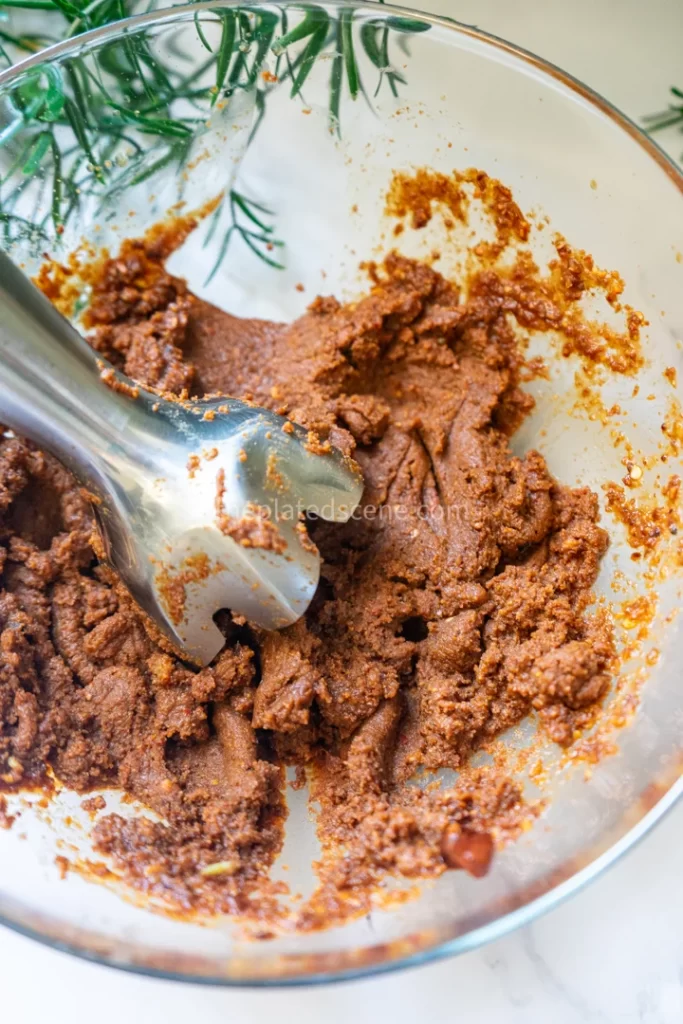
- Using a Food Processor:
Add the ingredients to a food processor. Start blending, and slowly add hot water to the processor. You may need to stop and scrape the sides of the food processor to ensure all ingredients are well-blended. Blend until the sauce becomes smooth and creamy. If the sauce seems too thick, add more water until you reach your desired consistency.
Traditional Method Using Mortar and Pestle:
If you prefer the traditional method, use a mortar and pestle to grind the fried peanuts and other ingredients. Start by grinding the peanuts with the pestle in the mortar until they release their oils and become a paste. Then, add the chili padi, fried garlic, and gula Malaka (along with salt and sweet soy sauce), and continue grinding until all ingredients are well combined. Gradually add hot water to achieve the desired consistency, adjusting as needed. This method adds an authentic touch and a slightly textured finish to the sauce.
Step 4a: Storage Instructions
If you wish to keep the peanut sauce longer, store it in an airtight container in the refrigerator. It can be kept for up to 1 week. The thicker consistency will help preserve the sauce, and you can use it for several servings. You can also freeze the peanut sauce in an airtight container for up to 3 months. When ready to use, thaw it and add water to adjust the consistency as needed.
Step 4b: Preparation Before Use
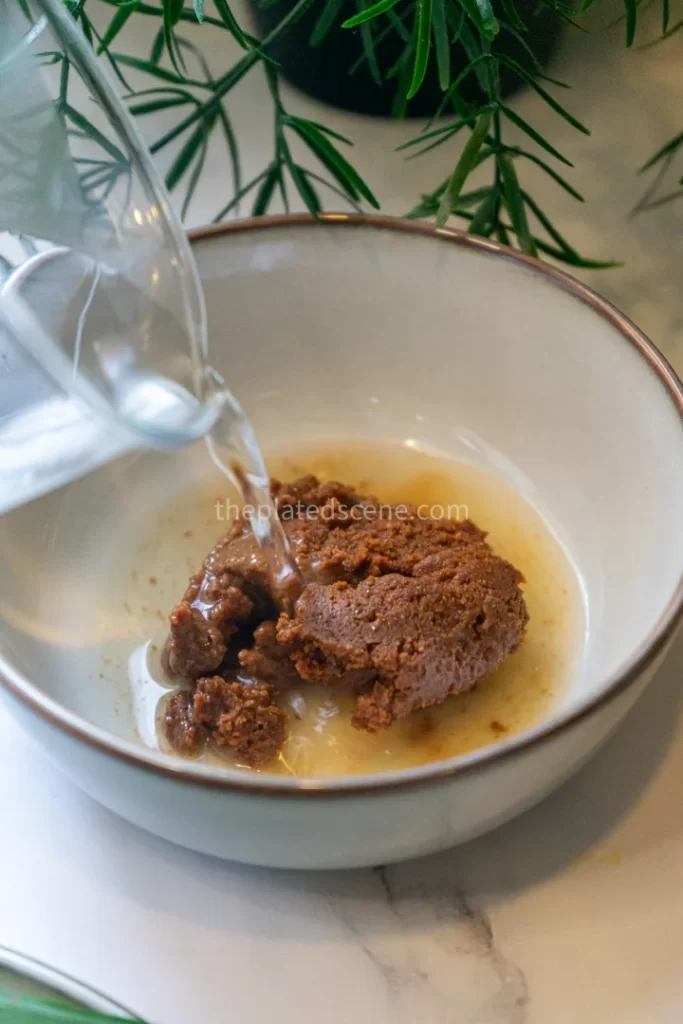
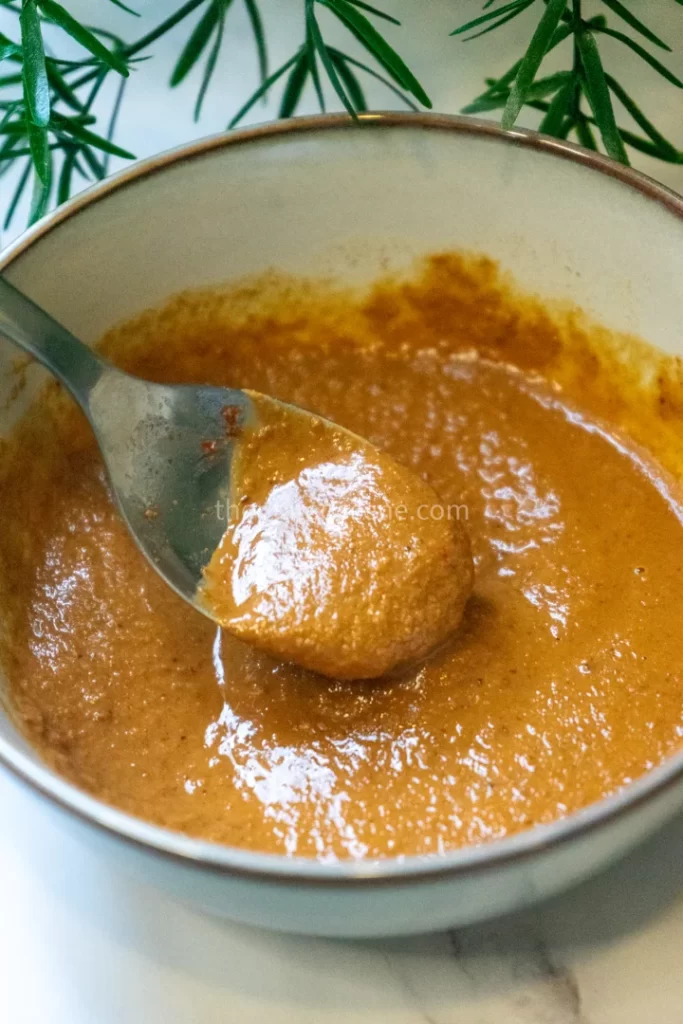
Before serving, you may find the peanut sauce too thick. Dissolve it with more water (up to your desired consistency) to make pouring over the rice cakes, tofu, tempeh, and bean sprouts easier. Add water gradually until you reach the smooth, slightly runny texture you prefer for serving.
Step-by-Step Guide to Assembling Ketoprak
Assembling Ketoprak is a simple process that combines layers of flavor and texture. Here’s how to put it together, step by step:
Step 1: Start with the Peanut Sauce
Begin by spreading a generous amount of peanut sauce on the bottom of your plate or bowl. The rich, creamy peanut sauce serves as the base of your Ketoprak, providing depth and flavor for the entire dish.
Step 2: Add the Beehoon (Rice Vermicelli)
Next, layer beehoon noodles (rice vermicelli) over the peanut sauce. The soft, slightly chewy noodles soak up the sauce and add texture, making it a satisfying component.
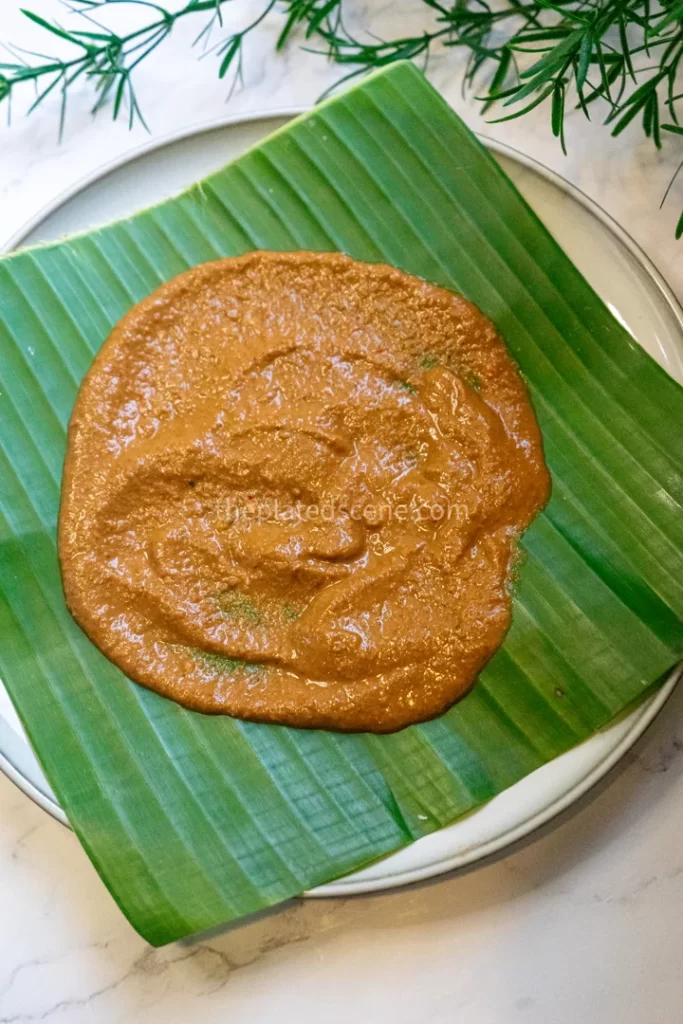
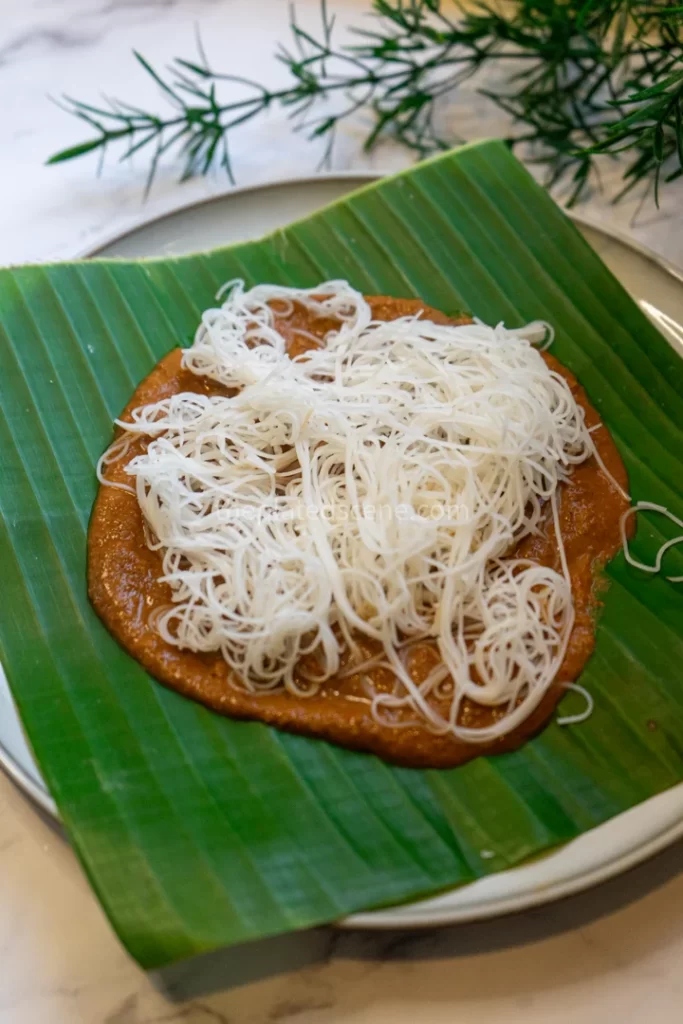
Step 3: Layer the Bean Sprouts
Add a handful of bean sprouts on top of the beehoon. Their fresh, crunchy texture creates a wonderful contrast to the noodles’ softness and the peanut sauce’s richness.
Step 4: Add the Lontong (Rice Cake)
Place slices of lontong (compressed rice cakes) over the bean sprouts. The rice cakes provide a chewy bite and absorb the peanut sauce, making each bite flavorful.
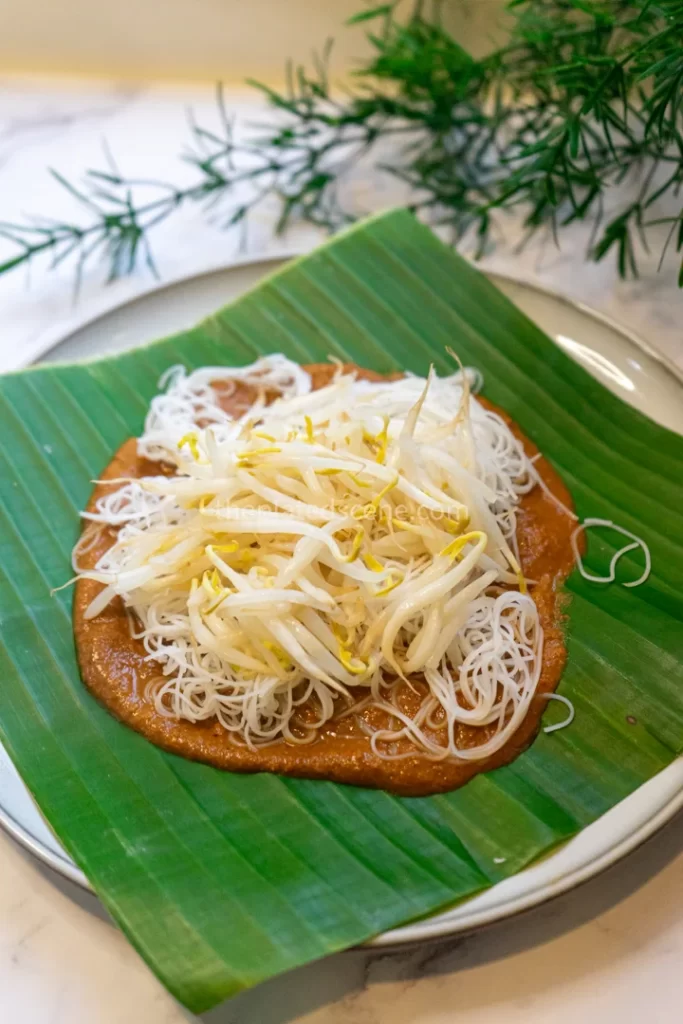
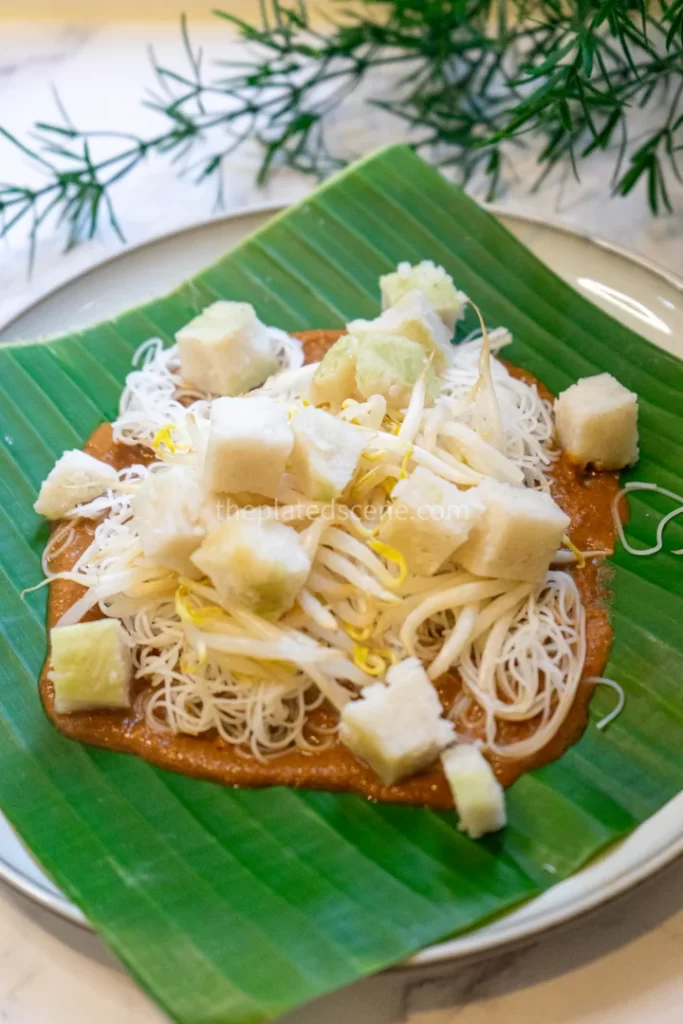
Step 5: Add the Protein
Top everything with your choice of protein, such as fried tofu and tempeh. The tofu should be golden and crispy on the outside while remaining soft inside, while tempeh adds a nutty, chewy texture.
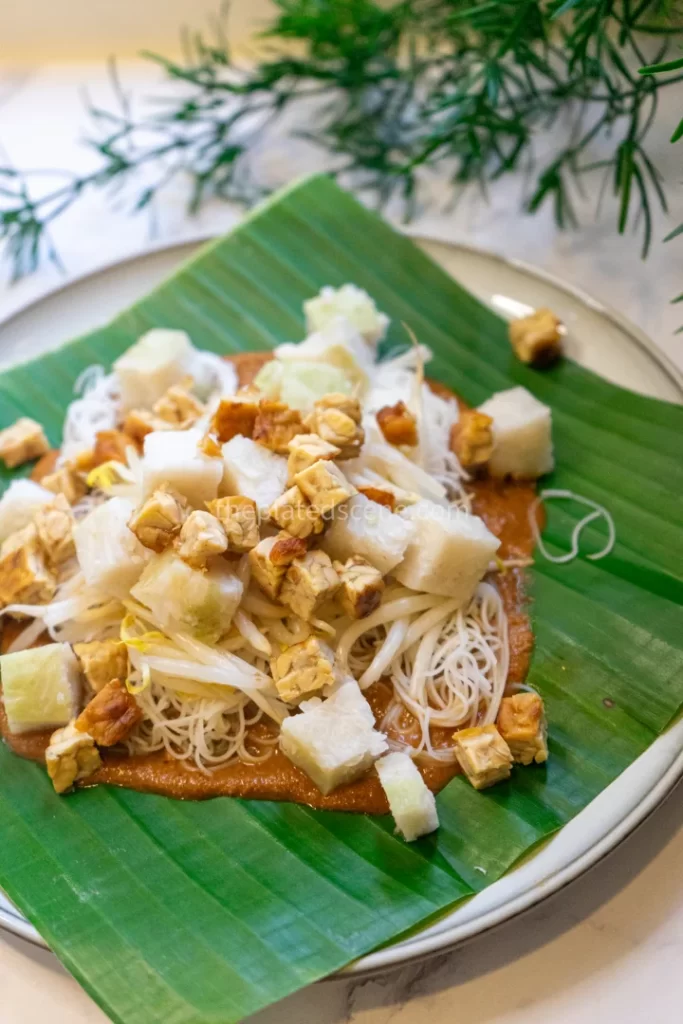
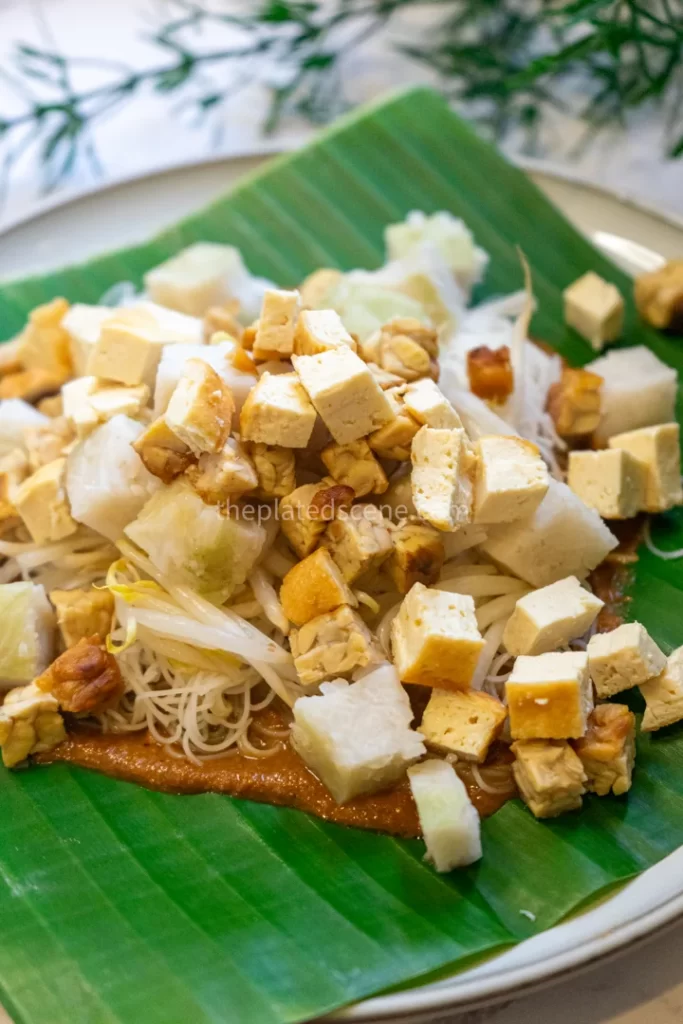
Step 6: Final Touches
Drizzle a little sweet soy sauce over the top for sweetness. Garnish with fried shallots for extra crunch and flavor. Finally, add kerupuk (crispy crackers) to give your Ketoprak a satisfying crunch.
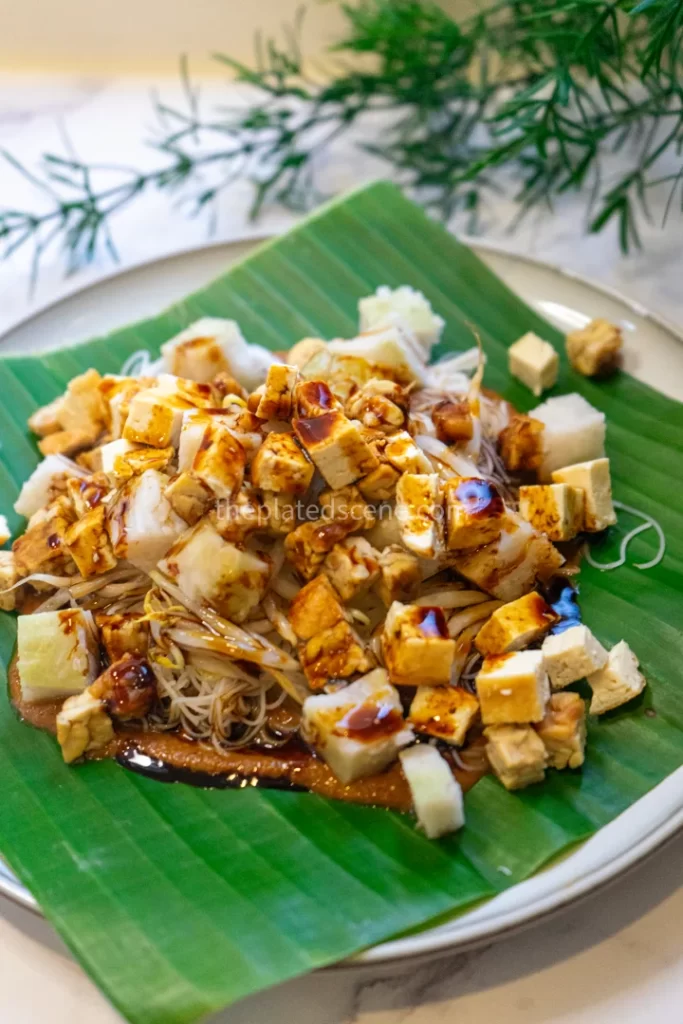
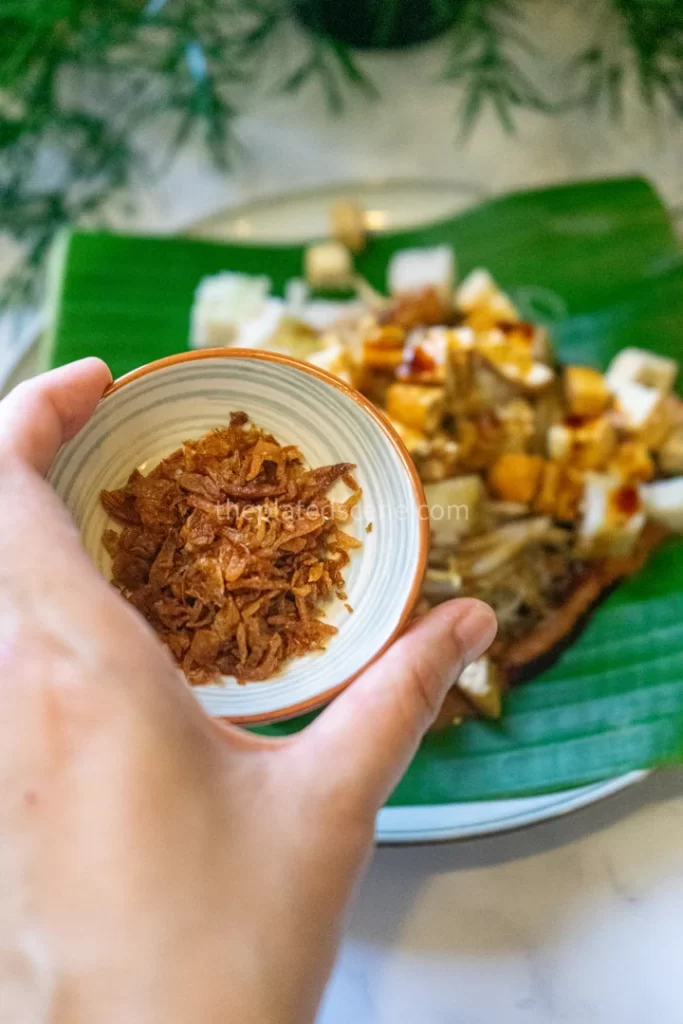
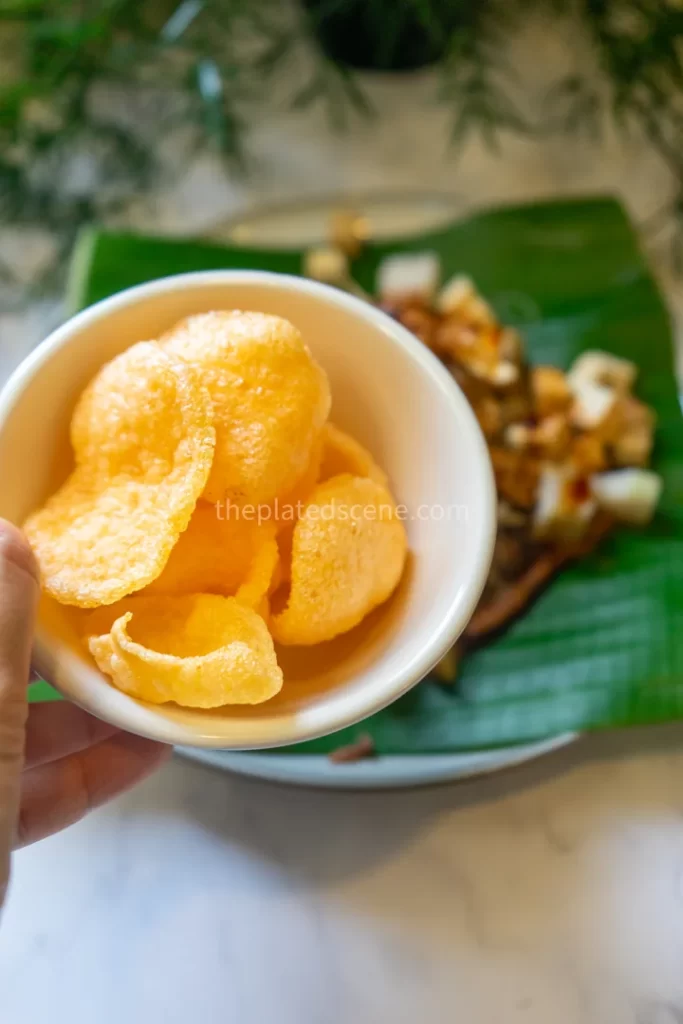
Mix everything and enjoy your delicious and customizable Ketoprak!
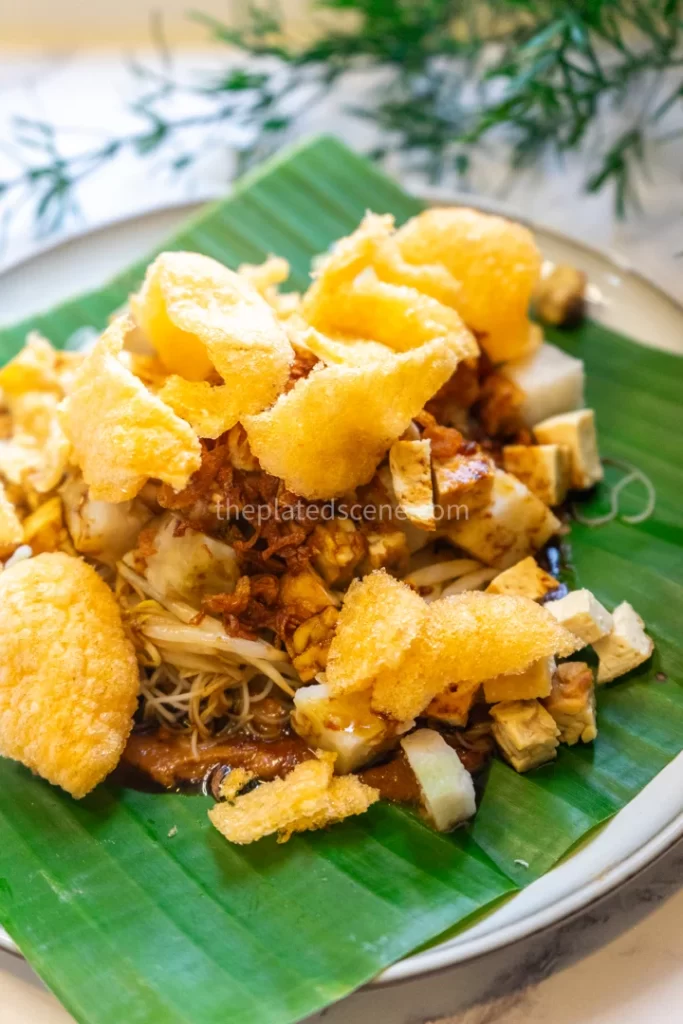
If you loved making Ketoprak, you’ll surely enjoy exploring more Indonesian dishes. From the rich flavors of Gudeg to the savory Terik Tahu Tempe, there are endless possibilities to try. Here are a few more recipes that capture the essence of Indonesian cuisine:
- Gudeg Yogyakarta Recipe – A traditional dish from Yogyakarta made with jackfruit, coconut milk, and spices.
- Terik Tahu Tempe Recipe – A hearty, flavorful dish featuring tofu and tempeh cooked in a rich, spiced coconut sauce.
- Mushroom Satay Recipe – A delicious vegetarian twist on the classic satay, with grilled mushrooms in a flavorful peanut sauce.
Explore these dishes to bring even more authentic Indonesian flavors to your table!


